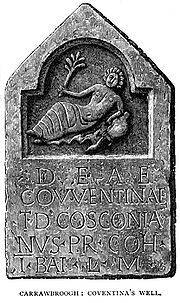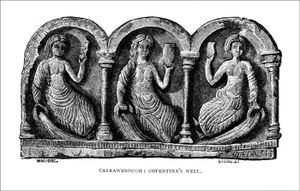- Coventina
-
Coventina
Coventina es la diosa celta de las aguas. Representa la abundancia y la fecundidad.
Fue adorada en el sur de Francia, en la provincia de Lugo y muy especialmente en el norte de Inglaterra. En esta última zona, concretamente en Carrawburgh, condado de Northumberland, se encuentra un templo en su honor, situado en la muralla de Adriano, donde se han encontrado gran cantidad de restos arqueológicos, como monedas, piedras, anillos, cristalería y cerámicas. Es por ello que se cree que este lugar tuvo que ser abandonado a finales del siglo IV, probablemente debido a un edicto anti-pagano del emperador romano Teodosio I.
Véase también
Categorías: Mitología celta | Dioses celtas | Dioses del agua
Wikimedia foundation. 2010.


